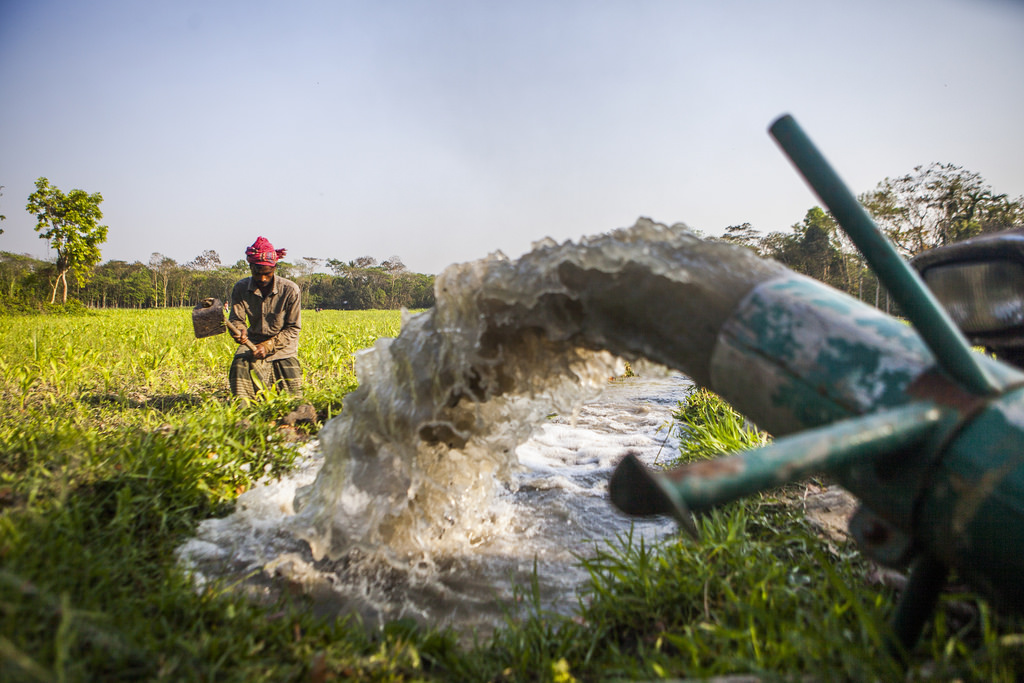

Opinion: Aligning our food security and environmental goals: The case for greening Asia’s irrigation
October 31, 2018
Louise Whiting
Water Management Officer, UN Food and Agriculture Organization, Asia Pacific Regional Office, Bangkok
For over half a century, irrigation systems have been critical to the dramatic improvements in food security and poverty eradication across Asia
Asia was once a continent that experienced regular famine. The Great Chinese Famine of 1959, where some 60 million Chinese people perished, is an extreme example of the hunger and starvation that plagued the region for decades. But, read down a global list of major famines since the 1960s and you will immediately notice that Asia has managed to largely and successfully remove itself from the dire inventory.
The continent’s impressive food security achievements can mostly be accredited to the new technologies ushered in by the Green Revolution. Fertilizers, pesticides, high-yielding varieties of seeds and reliable water supplies helped the region’s economies shift from food deficit to food surplus in less than a decade (Mukherji et al., 2009). Irrigation played a central role in this remarkable transformation by providing the essential buffer against climate variability. It allowed farmers to increase yields and cropping intensities so they could more effectively produce the additional food needed to feed Asia’s fast-growing population (Mukherji et al., 2009).

Food security progress at the expense of the environment
From the large-scale irrigation schemes, with their thousands of kilometres of canals that traverse swathes of the Asian landscape, to the millions of unregulated tube-wells drilled by farmers to sustain small-scale systems with groundwater – irrigation has had a tremendous impact on freshwater ecosystems in terms of water quality, quantity, timing of river flows and connectivity.
Negative impacts include major disruptions to the hydrologic regimes (and their dependent ecosystems) caused by dams, weirs, canals and exploitation of groundwater. Overuse of nutrients and agricultural chemicals affects both aquatic and terrestrial ecosystems, and has led to increased resistance of insects to pesticides. Improper management of schemes has led to water logging and salinization in some areas, and depletion in others. Drainage of wetlands to produce our food eliminates habitats and affects ecosystem characteristics such as fisheries, flood retention and groundwater recharge.
The situation is worrying and the need to act urgent. According to WWF’s Freshwater Living Planet Index, the populations of freshwater dependent species have declined by a massive 81% since 1970 (WWF, 2016). Projections for the future are no better. Conservative estimates suggest up to 75% of freshwater fish species are headed for local extinction by 2070 (Xenopoulus et al., 2005).
The need for a paradigm shift in water and irrigation management
Irrefutably, the next generation of irrigation system managers need to find ways to generate more value from ecosystem services and reverse environmental decline. This must be achieved while simultaneously enabling farmers to increase their productivity and incomes, respond to volatile market conditions and build resilience to a changing climate (Mukherji et al., 2009). This is a monumental challenge, but one we must tackle if we are to bring Asian food systems, and the irrigation that underpins them, within the limits of sustainability. Fortunately, there are numerous approaches to irrigation scheme design and management that can support the rapid transition that is needed.
First and foremost, decisions regarding the way our irrigation schemes are constructed, rehabilitated and modernized must be based on water accounting.1 Water accounting is particularly critical where water resources are scarce and competition between different users intensifies – a situation I’m often surprised to encounter even in the tropical climates of Indonesia, Malaysia and Vietnam.
As scarcity worsens, many from within the irrigation sector are all-too-ready to encourage farmers to switch to drip and sprinkler technologies. For years the ‘solution’ to increasing water scarcity has been to increase irrigation efficiency thereby ‘saving water’ to release to the environment. But a growing body of evidence shows that these technologies usually increase consumption of water by irrigation (Gómez and Pérez-Blanco, 2014; FAO, 2012; Batchelor et al., 2014; Perry and Steduto 2017; Linstead, 2018). And where consumption increases, it is the environment’s residual water needs that will bear the brunt of misinformed irrigation investments.
Reorienting irrigation infrastructure, operation and maintenance towards environmental objectives
Irrigation infrastructure across Asia is in a constant state of construction, rehabilitation or modernization. These processes are underpinned by very large investments that provide an opportunity to do things differently (for example, over two billion US dollars is programmed for spending on irrigation construction and rehabilitation in Indonesia alone). There are multiple design and management innovations for irrigation infrastructure that can enhance aquatic biodiversity and the yields of inland fisheries. Building fish passes, protecting existing habitat, creating refuges and wetlands, adapting water releases to minimize disruption to natural flow regimes, and working with user groups to change behaviour and sustain change can all be adopted to improve environmental outcomes while upgrading irrigation infrastructure (McCartney et al., 2018; Baumgartner and Wibowo, 2018).
It’s possible to take the thinking around greening irrigation infrastructure one step further. We must collectively recognize that irrigated landscapes (when properly managed) are providers of a number of vital services that support our food systems, our communities and our environment. For example, large-scale canal schemes can function as ecological corridors, providing capacities as refuges for certain fish species under stress and connecting upstream and downstream zones over a continuum of more than 300 km (Aspe et al., 2014). Irrigated landscapes can create positive microclimates, serve as habitat for aquatic and terrestrial flora and fauna and recharge groundwater. The principles of agroecology, and the examples of successful integration of irrigated and peri-urban landscapes in countries like Korea, Japan and Taiwan, serve as sources of inspiration and knowledge. Preserving and enhancing the valuable functions served by well-managed and well-integrated irrigated landscapes will be vital in the face of continuing rapid urbanization across Asia.
Promoting new coalitions for change
Irrigated agriculture has provided enormous benefits to society – and must continue to do so but with sustainability at the forefront of our planning. Investors and irrigation scheme managers have an obligation to minimize or mitigate the potential negative impacts of irrigation on the ecosystems that underpin our food systems. Practitioners and policy-makers must recognize that irrigation interacts in complex, dynamic ways with the landscape in which it is situated. By adopting an integrated landscape perspective, managers can make better-informed decisions. Choosing from a suite of available options, they can shape the process of experimentation, investment, implementation and mainstreaming into policy that is required. A vital first step is to facilitate the systematic interaction between water management, irrigation, environment and fisheries practitioners. Together they can solve the difficult trade-off decisions that are inevitable and ensure the future of irrigation development is better aligned with our environmental sustainability goals.
1Defined as any systematic method of organizing and presenting information relating to the physical volumes and flows of water in the environment as well as the economic values of water through cost-benefit analysis
Louise Whiting
 Louise currently leads the regional Land and Water programme for the UN Food and Agriculture Organization from the Asia Pacific Regional Office in Bangkok. The program focuses on reducing the environmental impacts of food production, addressing water scarcity in agriculture and building farmer resilience to climate change. Previous to joining FAO, Louise was a senior policy analyst at WaterAid where she worked across Africa and Latin America focussed on water security and climate finance. She also served as a political advisor to the NSW Minister for Water during the Murray-Darling Basin reform period.
Louise currently leads the regional Land and Water programme for the UN Food and Agriculture Organization from the Asia Pacific Regional Office in Bangkok. The program focuses on reducing the environmental impacts of food production, addressing water scarcity in agriculture and building farmer resilience to climate change. Previous to joining FAO, Louise was a senior policy analyst at WaterAid where she worked across Africa and Latin America focussed on water security and climate finance. She also served as a political advisor to the NSW Minister for Water during the Murray-Darling Basin reform period.
References
Aspe, C., Gilles, A., & Jacqué, M. (2014). Irrigation canals as tools for climate change adaptation and fish biodiversity management in Southern France. Regional Environmental Change, 16(7), 1975–1984.
Batchelor, C., Reddy, V. R., Linstead, C., Dhar, M., Roy, S., and May, R. (2014). Do water-saving technologies improve environmental flows? J. Hydrol. 518, 140–149. doi: 10.1016/j.jhydrol.2013.11.063
Baumgartner, L., Wibowo, A. 2018. Addressing fish-passage issues at hydropower and irrigation infrastructure projects in Indonesia. Marine and Freshwater Research – http://sci-hub.tw/10.1071/MF18088
FAO. (2012). Coping with water scarcity: an action framework for agriculture and food security. FAO Water Reports, 38.
Gómez, C.M., Pérez-Blanco, 2014. Simple Myths and Basic Maths About Greening Irrigation. Water Resources Management 28(12), 4035-4044]
Linstead C (2018) The Contribution of Improvements in Irrigation Efficiency to Environmental Flows. Front. Environ. Sci. 6:48. doi: 10.3389/fenvs.2018.00048
McCartney M, Funge-Smith S and Kura Y. 2018. Enhancing fisheries productivity through improved management of reservoirs, dams and other water control structures. Penang, Malaysia: CGIAR Research Program on Fish Agri-Food Systems. Program Brief: FISH-2018-11
Mukherji, A.; Facon, T.; Burke, J.; de Fraiture, C.; Faurès, J.-M.; Füleki, B.; Giordano, M.; Molden, D.; Shah, T. 2009. Revitalizing Asia’s irrigation: to sustainably meet tomorrow’s food needs. Colombo, Sri Lanka: International Water Management Institute; Rome, Italy: Food and Agriculture Organization of the United Nations.
Perry, C., and Steduto, P. (2017). Does Improved Irrigation Technology Save Water? A Review of the Evidence. Cairo: Food and Agriculture Organization of the United Nations.
WWF (2016). Living Planet Report 2016. Risk and Resilience in a New Era. Gland: WWF International.
M. A. Xenopoulos et al., Scenarios of freshwater fish extinctions from climate change and water withdrawal. Global Change Biol. 11, 1557–1564 (2005). doi: 10.1111/j.1365-2486.2005.001008.x




